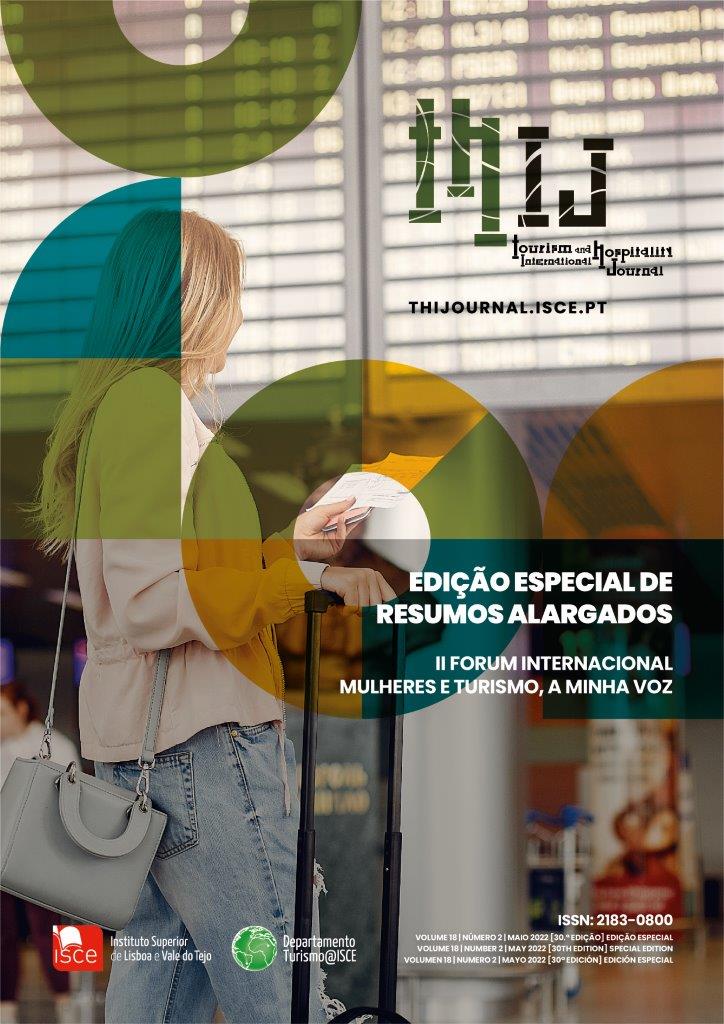DETERMINANT FACTORS IN THE CHOICE OF THE TOURISTIC TOUR BY BIKE THROUGH THE EYES OF WOMEN
DOI:
https://doi.org/10.57883/thij18(2)2022.31095Abstract
The increase in the search for an effective supply of urban road infrastructure has led to the continuous search for solutions for means of transportation compatible with the interests of the population of the cities. In this context, Lanzillotta (2013) states that means of locomotion, such as the bicycle emerges as a key element to sustainable urban development. Studies indicate that the bicycle has transposed its basic function of means of locomotion, added the activity of leisure and recreation and incorporated to the space of touristic interest. In the last years, the bicycle was incorporated to the urban mobility policy agenda of large cities. This happened slowly in the case of the city of São Paulo until the early 2010s, presenting greater intensity as of 2013 (Lemos, Harkot & Santoro, 2016).
This study takes a brief look at some general data on the use of bicycles for sightseeing around the city, particularly from the perspective of female cyclists. This preliminary analysis used surveys of women who visited the city of São Paulo by bike, with the starting questions: what are the challenges faced by women when touring the city of São Paulo? Does the city's cycling infrastructure promote any impact on the decision to use the bicycle during their rides? At the end, we seek to test the hypothesis about the act of pedaling representing a motivational factor for women to decide to use the bicycle in their rides in the city of São Paulo.
References
Boareto, R. (2008). A política de mobilidade urbana e a construção de cidades sustentáveis. Revista dos Transportes Públicos – ANTP. São Paulo, 30/31, 143 -160.
Campos, A., Santos, C. & Alves, L. (2016). Cicloturismo: Mobilidade urbana e valorização do turismo da cidade de Aracaju – Sergipe. Revista de Direito da Cidade. Rio de Janeiro. 8, 1800 – 1824.
Companhia de Engenharia de Tráfego CET. (2019). Cartilha do ciclista. Disponível em: <http://www.cetsp.com.br/media/426143/CartilhaDoCiclista.pdf>.
Decastro, J., Saldanha, L. & Edra, P. (2016). Mobilidade cicloviária: A convergência entre o urbano e o turístico. In: Mobilidade por bicicleta no Brasil / organizadores, Andrade, V., Rodrigues, J., Marino, F., Lobo, Z. – Rio de Janeiro: PROURB/UFRJ.
Dickinson, J. & Lumsdon, D. (2010). Slow Travel and Tourism. London: Earthscan.
Emond, C., Tang, W. & Handy, S (2009). Explanning gender difference in bicycling behavior. Transportation Research Record: Journal of the Transportation Research Board 2125(1), 16-25.
Faulks, P., Ritchie, B. & Fluker, M. (2007). Cycle tourism in Australia: An investigation into its size and scope. CRC for Sustainable Tourism, Brisbane.
Garrard, J (2003). Healthy revolutions: Promoting cycling among women. Healthy Promotion Journal of Australia 14(3), 213-215.
Hanson, S. (2010). Gender and mobility: New approaches for informing sustainability. Gender, Place & Culture: A Journal of Feminist Geography 17(1), 5-23.
Hogson, L. (2007). Bicycle touring and the construction of place: A study of place meanings on a cycle tour of Tuscany, Italy (pp. 25-41). In F. Jordan, L. Kilgour & N. Morgan (eds). Academic renewal: Innovation in leisure and tourism themes and methods, 97. Eastbourne: Leisure Studies Association.
Instituto de Energia Meio Ambiente- IEMA. (2010). A bicicleta e as cidades: como inserir a bicicleta na política de mobilidade urbana. São Paulo. Disponível em: <http://www.solucoesparacidades.com.br/wp-content/uploads/2010/01/02%20-%20BRASIL_A%20bicicleta%20e%20as%20cidades_IEMA.pdf>.
Lamont, M. (2009). Reinventing the wheel: A definitional discussion of bicycle tourism. Journal of Sport & Tourism. 14, 1, 5-23.
Lamont, M., & Causley, K. (2010). Guiding the way: Exploring cycle tourists’ needs and preferences for cycling route maps and signage. Annals of Leisure Research, 13 (3), 497–522.
Lanzillotta, A. (2013). Cicloturismo: Por uma diversificação do turismo realizado na cidade do Rio de Janeiro. Niterói: Universidade Federal Fluminense.
Lee, C.-F. (2014). An investigation of factors determining cycling experience and frequency. Tourism Geographies, 16 (5), 844–862.
Lemos, L., Harkot, M & Santoro, P. (2016). Mulheres de bicicleta: Como pedalam as mulheres em São Paulo. In V. Andrade, J. Rodrigues, F. Marino & Z. Lobo (eds). Mobilidade por bicicleta no Brasil. Rio de Janeiro: PROURB/UFRJ. P. 265-284.
Ministério das Cidades, (2005). Conheça o anteprojeto de lei da política nacional de mobilidade urbana. Mobilidade urbana é desenvolvimento urbano. Pólis Instituto de Estudos, Formação, Assessoria em Políticas Sociais. Brasília. Disponível em: <https://www.polis.org.br/uploads/922/922.pdf>.
Netto, A. (2003). O papel da regulação – direito ao transporte e a mobilidade urbana sustentável: Instrumento de combate à pobreza pela inclusão. Revista dos Transportes Públicos – ANTP. São Paulo. Ano 25, 3° trimestre.
Quivy, R. & Campenhoudt, L. (2005). Manual de investigação em ciências sociais. Lisboa: Gradiva.
Sassatelli, C. & Ishikawa, M. (2018). Conheça os sistemas de compartilhamento de bicicletas e patinetes. Auto Esporte. Disponível em: <https://revistaautoesporte.globo.com/Noticias/noticia/2018/08/compartilhamento-de-bicicletas-grandes-cidade.html>.
Schetino, A. (2006). O cicloturismo como vivência crítica e criativa de lazer. Belo Horizonte: Centro de Estudos em Lazer e Recreação (CELAR) – Monografia especialização em Lazer na Universidade Federal de Minas Gerais.
Silveira, M. & Maia, M. (2015). Variáveis que influenciam no uso da bicicleta e as crenças da teoria do comportamento planejado. Transportes, 23 (1), 24-36.
Simpson, C. (2001) Respectable identities. New Zealand nineteenth-century ‘new women’ – on bicycles! The International Journal of the History of Sport 18(2), 54-77.
Valente, M. (2006). Fatores importantes para a escolha do telefone celular pelo consumidor adolescente. Dissertação de Mestrado Profissionalizante em Administração. Rio de Janeiro: IBMEC.
Yeh, C.-C., Lin, C. J.-Y., Hsiao, J. P.-H., & Huang, C.-H. (2019). The effect of improving cycleway environment on the recreational benefits of bicycle tourism. International Journal of Environmental Research and Public Health, 16 (18), 3460.
Downloads
Published
How to Cite
Issue
Section
License
Copyright (c) 2021 This work is licensed under a Creative Commons - Attribution 4.0 International (CC BY 4.0)

This work is licensed under a Creative Commons Attribution 4.0 International License.
This work is published under the Creative Commons Attribution 4.0 International License.






